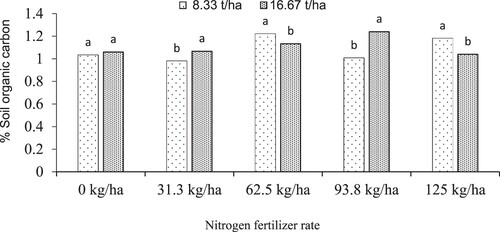 ?Mathematical formulae have been encoded as MathML and are displayed in this HTML version using MathJax in order to improve their display. Uncheck the box to turn MathJax off. This feature requires Javascript. Click on a formula to zoom.
?Mathematical formulae have been encoded as MathML and are displayed in this HTML version using MathJax in order to improve their display. Uncheck the box to turn MathJax off. This feature requires Javascript. Click on a formula to zoom.Abstract
Lettuce (Lactuca sativa L.) efficient use of nitrogen (NUE) determines its growth and yield. We assessed the interaction effect of N fertilizer and biochar of different particle sizes and rates on NUE, growth and yield of lettuce. A factorial design arranged in Randomized Complete Block Design with four replications was used to conduct a field experiment at the FRNR farm, Kwame Nkrumah University of Science and Technology, Ghana. The treatment consisted of biochar at 8.33 t and 16.67 t ha−1 with different particle sizes (<2, 5 and 10 mm) and five rates (0, 31.3, 62.5, 93.83 and 125 kg ha−1) of inorganic N fertilizer. Our result showed that integrating 8.33 t ha−1 of <2 mm and 5 mm biochar with 62.5 and 93.8 kgN ha−1, respectively improved lettuce growth, NUE by 30% and yield. The yield (19.3 t ha−1) obtained with these applications is comparable to the achievable yield (20 t ha−1) of lettuce under the sole N recommended rate (125 kgN ha−1). In conclusion, with 8.33 t ha−1 of <2 mm biochar, farmers can reduce the recommended inorganic N rate of lettuce by half (62.5 kg ha−1) and still attain good yield with improved post-harvest soil fertility. This has implications for farmers’ production costs, agriculture waste management and climate change mitigation strategies.
Introduction
In Ghana and many Sub-Sahara African countries, lettuce farming is among the most prevalent agricultural activity, serving as an important source of employment and livelihood to rural people (Quansah et al. Citation2020; Abdulai et al. Citation2017). In addition, it is an important component of the human diet with a significant amount of minerals, proteins and vitamins (Das and Bhattacharjee Citation2020). Unfortunately, the current yield of lettuce is about 9.5 t ha−1 compared to an achievable yield of 40 t ha−1 (Gashaw and Haile Citation2020). One major cause of such low yields is the poor soil nutrient content, especially nitrogen (N), coupled with low soil moisture/water resulting in reduced soil fertility and unstable soil microbial activities (Badu et al. Citation2019; Sertan and Taş Citation2022). Furthermore, the reduced land productivity is associated with incessant husbandry plus rapid mineralization of living biomass applied as a source of organic manure (Badu et al. Citation2019). Unfortunately, leafy vegetables including lettuce have a high demand for soil N and, the yield depends on the response to N and how efficiently the crop uses the available soil N (Oladele et al. Citation2019; Woldetsadik et al. Citation2017; Sanchez Citation2000).
The attempt to use the recommended rate of inorganic fertilizers to achieve optimum yield has not been successful due to the high fertilizer cost, difficulty in accessing the fertilizers by rural and peasant growers who constitute the majority (over 70%) of farmers in Ghana and the dwindled soil organic matter content when solely applied continuously (Yeboah et al. Citation2009; IFDC Citation2012; MoFA Citation2015; Badu et al. Citation2019).
Therefore, any innovation that enhances the sustainable production of lettuce with a consequent reduction in environmental pollution that threatens human health as a result of higher use of inorganic fertilizers must be given critical consideration.
One current innovation in sustainable agriculture production with climate/environmental benefits is the use of biochar for soil amendment. Biochar is a highly aromatic form of organic matter that has the potential for soil fertility improvement, toxic element adsorption and climate change mitigation benefits (Fahad et al. Citation2016, Citation2021a, Citation2021b; Abbhishek et al. Citation2021; Chandra et al. Citation2021).
The research gap in biochar-based soil management strategies in developing countries like Ghana has been well discussed (Moses et al. Citation2011; Fagbenro et al. Citation2018; Badu et al. Citation2019). Even when studies have been done, the findings have pointed out the limitation in applying either sole biochar (Vanlauwe et al. Citation2011; Tittonell and Giller Citation2013; Naeem et al. Citation2018; Alharby and Fahad Citation2020) or sole inorganic fertilizers (Agyare et al. Citation2014; Badu et al. Citation2019).
Therefore, the general advocacy has been a combined use of biochar and inorganic fertilizers (Badu et al. Citation2019; De Gryze et al. Citation2010).
For instance, Trupiano et al. (Citation2017); Faloye et al. (Citation2017) and Oladele et al. (Citation2019) indicated that a combination of biochar with fertilizers for soils poor in fertility had a more significant effect on crop yield due to reduced nutrients loss and increased fertilizer use efficiency. The few research works that combined biochar and inorganic fertilizers have focused on cereal crops (not vegetables) and the biochar rate, but the biochar particle size has not been given the needed attention. Thus, many researchers (Alghamdi et al. Citation2020; Esmaeelnejad et al. Citation2016; Liu et al. Citation2016) have indicated the limited studies that have examined the effects of different sizes of biochar particles on soil chemical properties and crop yields. For instance, Nobile et al. (Citation2020); Lia et al. (Citation2019) and Chen et al. (Citation2017) have reported that the particle size of biochar can influence the liming effect, nutrient exchange, soil water storage capacity and plant growth responses but indicated that data remains scarce. In addition, the recent study by Alghamdi et al. (Citation2020) and Are (Citation2019) reported how different particle sizes of biochar can enhance soil characteristics and crop yield but bemoaned the less research attention it has received. Finally, it is important to indicate that, Liao and Thomas (Citation2019) had confirmed that prior to their study, there was no study that explicitly assessed the effects of biochar particle size to stimulate plant growth. We build on these research works, by integrating inorganic N fertilizer at different rates with different biochar sizes and rates to address soil fertility and plant nutrients challenges (e.g. N) faced by lettuce farmers in Ghana and Sub-Sahara Africa.
In our study, biochar with an internal diameters of <2, 5 and 10 mm (hereafter called small, medium and coarse, respectively) was used based on the modified recommendation of Lim et al. (Citation2017) and Obia et al. (Citation2016).
The study tested the hypothesis that the interactive effect of N fertilizer and biochar of different particle sizes and rates will increase the NUE, improve the growth and yield of lettuce and significantly reduce the current 125 kg N ha−1 required by lettuce when N fertilizer is solely applied.
Materials and methods
Experimental site
The experiment was carried out at the Faculty of Renewable Natural Resources (FRNR) research farm of the Kwame Nkrumah University of Science and Technology (KNUST) in Kumasi, Ghana (Figure ). The study site is located in the moist Semi-Deciduous Forest zone of Ghana and it lies on Latitude 6° 40′ and longitude 1° 34′ W. The site experiences bimodal rainfall pattern with average yearly rainfall ranging from 1200 to 1500 mm.
The main rainy season starts in March and lasts until July, while the minor rainy season starts in late August and lasts until November (Kaba and Abunyewa Citation2021).
There is also a dry season from December to March with a mean annual temperature of 26.6°C. The average warmest temperature of 33°C occurs in March while the lowest temperature of 20°C occurs in December to February (Badu et al. Citation2019). The initial properties of the topsoil (0–20 cm) showed a pH of 5.8, organic carbon of 1.2 g kg−1, total nitrogen of 0.5 g kg−1 and organic matter of 2.07 g kg−1. The soil physical characteristics showed a textural class of Sandy-loam (Badu et al. Citation2019).
Biochar production
Maize (Zea mays L) and Acacia spectabilis biomass were used to produce the biochar. The organic materials were charred at the FRNR Research farm. The biochar was later crushed to obtain the different-sized particles. The different sizes were then obtained by sieving with selected mesh size sieves to get the 10 mm (coarse), 5 mm (medium) and <2 mm (fine) sized biochar particles for the experiment, based on diameter as suggested by Lim et al. (Citation2017), Obia et al. (Citation2016) and Liao and Thomas (Citation2019).
Experimental design
Factorial design (2 × 3×5) arranged in Randomized Complete Block Design (RCBD) was used for the experiment. The study evaluated the effect of biochar at two (2) application rates; 8.33 and 16.67 t ha−1 and three (3) particle sizes; fine (<2 mm), medium (5 mm) and coarse (10 mm) biochar and five (5) rates of inorganic N fertilizer (0, 31.3, 62.5, 93.83 and 125 kg N ha−1). There were four treatment replications within a total experimental area of 16 m × 22 m and each plot measuring 1.0 m × 0.6 m (0.6 m2) with 1 m between the blocks.
Treatment application
The experiment was carried out in the major and minor cropping seasons of 2017/2018. In both seasons, two rates of biochar at 8.33 and 16.67 t ha−1 were applied. The biochar was manually incorporated into the soil with a hand fork. The rates for the inorganic fertilizer were 0 kg N ha−1 as control, 31.3, 62.5, 93.83 and 125 kg N ha−1 (recommended rate). In addition, the recommended basal rate of 125 kg P2O5 ha−1 and 166.67 kg K2O ha−1 in the form of triple superphosphate and muriate of potash, respectively, were applied.
Cultural practices and data collection
In both seasons, the lettuce seeds were nursed on a nursery bed and germination started 6 days after nursing. Seedlings were then transplanted at a spacing of 20 cm × 15 cm. Watering was done soon after transplanting and subsequently regularly to ensure the good establishment of plants while weeding was done manually whenever weeds were detected. Caterpillar and grasshoppers were controlled with a non-systemic insecticide (Attack 5% WDG insecticide). The pesticide was diluted at a ratio of 10 g to 16 L of water and sprayed directly onto the plants.
Data were taken on plant height, number of leaves and yield per plot for both seasons. Data were taken from the two middle rows (12 plants on each plot) for 6 consecutive times.
Yield was obtained by weighing the fresh lettuce plants from the two middle rows at the end of the experiment using an electronic balance. Yield was then calculated for each plot.
The agronomic Nitrogen Use Efficiency (NUE) (N-AE), defined as the incremental crop yield (expressed in kg ha−1) per applied nitrogen (Ichami et al. Citation2019) was calculated following Vanlauwe et al. (Citation2011):
where YNA is the yield (kg ha−1) with N addition. YNO is the yield (kg ha−1) without N addition. NRM is the rate of N addition (kg ha−1).
Soil sampling and analyses
In both seasons, soil analyses were carried out at the end of the experiment. Samples of soil were taken at different locations from all plots at the experimental site at a depth of 0–15 cm. They were homogenized and bulked to form an amalgamated sample for each plot. The composite soil sample was then air dried and sieved with a mesh sieve (2 mm) and laboratory analysis carried out for pH, organic carbon (C) and total nitrogen (N).
Data analyses
Data collected in both seasons were analysed using GenStat 12.1 and Statistix 9.1 software in which Analysis of Variance (ANOVA) was used to indicate significant effects of the treatments. Significant differences among treatment means were separated using the Least Significant Difference (LSD) at 5% probability level.
Result
Biochar and inorganic N fertilizer effect on leaf count and plant height of lettuce
The interaction effect of biochar rate and N fertilizer did not influence the leaf count; however, integrating N fertilizer with different biochar sizes had a significant (P < 0.05) effect on the leaf count (Figure ). Fine and medium size biochar combined with N fertilizer rate of 62.5 and 93.8 kg ha−1 respectively, had the highest leaf count, while the control, irrespective of the biochar size, had the lowest number of leaf count (Figure ).
Figure 2. Effect of biochar size and N fertilizer rate on the leaf count of lettuce (Average of two cropping seasons) grown in moist semi-deciduous rainforest of Ghana. Bars with different letters are significantly different at P < 0.05, values are means of leaf count taken at 5,6,7, and 8 weeks after planting.
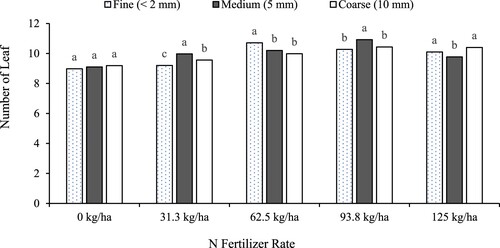
Similarly, the interaction effect of biochar size and fertilizer rate significantly (P < 0.05) influenced lettuce height (Figure ). The inorganic fertilizer combined with the different biochar sizes produced higher plant heights than the control (Figure ). Among the biochar sizes, fine (<2 mm) biochar combined with inorganic N fertilizer at the rate of 62.5 kg N ha−1 resulted in the highest plant height (13.8 cm) while coarse (10 mm) biochar at the rate of 125 kg N ha−1 produced the lowest plant height. Generally, the treated plots had an average plant height of 13 cm, while the control (0 kg N ha−1) produced the least plant height (9.9 cm) (Figure ).
Figure 3. Effect of inorganic N fertilizer and biochar size on lettuce height (average of two cropping seasons) grown in moist semi-deciduous rainforest of Ghana. Bars with different letters are significantly different at P < 0.05. Values are means of height measurement taken at 5, 6, 7 and 8 weeks after planting.
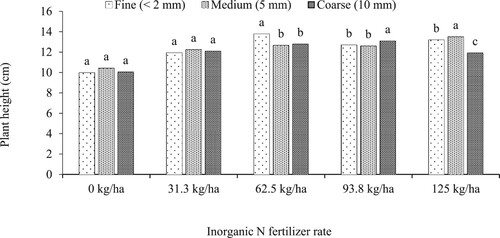
Biochar and inorganic N fertilizer effect on yield and NUE of lettuce
The interaction effect of biochar sizes and N fertilizer rates significantly (P < 0.05) influenced both lettuce biomass yield (Figure ) and NUE (Figure ). The inorganic fertilizer combined with the different biochar sizes produced a higher yield than the control (Figure ).
Figure 4. Effect of inorganic N fertilizer rates and biochar sizes on biomass yield of lettuce at harvest (average of two cropping seasons) grown in moist semi-deciduous rainforest of Ghana. Bars with different letters are significantly different at P < 0.05.
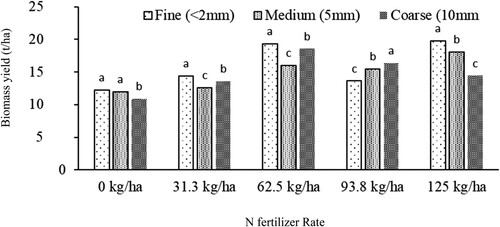
Figure 5. Effect of different biochar sizes and inorganic N fertilizer application rates on NUE of lettuce (average of major and minor cropping season). Data points are the means of four replicates. Bars represent standard error of means.
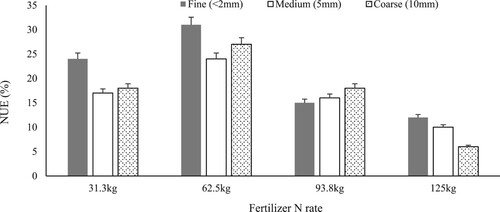
Among the biochar sizes, fine (<2 mm) biochar combined with inorganic N fertilizer at the rate of 62.5 kg N ha−1 recorded the highest biomass yield of 19.3 t ha−1 (Figure ) and NUE of 30%, while coarse (10 mm) biochar with 125 kg N ha−1 produced the lowest NUE of 6% (Figure ).
Biochar and inorganic N fertilizer effect on post-harvest soil organic carbon and total N concentration
The interaction effect of biochar sizes and N fertilizer application rates significantly (P < 0.05) influenced the soil % N at harvest (Figure ). Among the treated soils, fine and medium size biochar with the application rate of 62.5 and 93.8 kg N ha−1, respectively, had higher residual soil %N while coarse biochar at any N rate had the least %N (Figure ). However, all the biochar treated soils, irrespective of the size, had a higher % N than the control. Generally, fine and medium size biochar, with the application of 62.5 and 93.8 kg N ha−1 had the highest soil %N at harvest (Figure ).
Figure 6. Effect of inorganic N fertilizer and biochar size on soil % N after lettuce harvest (average of two cropping seasons). Bars with different letters are significantly different at P < 0.05.
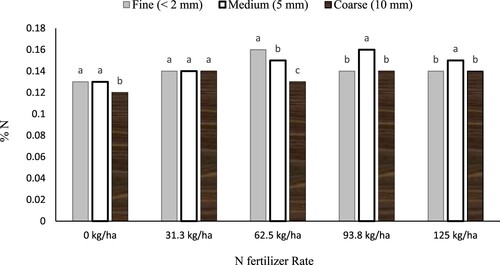
Similarly, the interaction effect of biochar sizes and fertilizer N rates resulted in a significant (P < 0.05) increase in soil organic carbon (SOC) (Figure ). The effect of fine biochar with 62.5 and 93.83 kg N ha−1 combination recorded the highest increase of over 20% and 15% in SOC, respectively, compared to the control. However, applying coarse biochar with 62.5 kg N ha−1 resulted in the least (5%) SOC (Figure ).
Figure 7. Inorganic N fertilizer rate and biochar size effect on SOC after lettuce harvest (average of two cropping seasons). Bars with different letters are significantly different at P < 0.05.
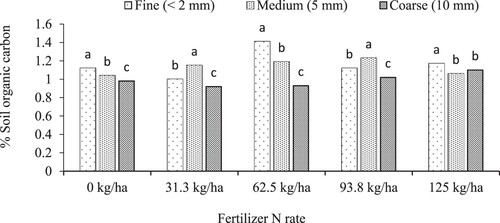
The effect of inorganic fertilizer application on soil organic carbon (% SOC) was also significantly (P < 0.05) influenced by varying the application rates of biochar (Figure ). Raising the rate of biochar application from 8.33 to 16.67 t ha−1 resulted in an increase in % SOC, the order of increment was 0 kg ha−1 < 2.6% < 31.3 kg ha−1 < 8% < 93.83 kg ha−1. Conversely, 62.5 and 125 kg N ha−1 recorded about 8% and 13% declines, respectively, when the rate of biochar was raised from 8.33 to 16.67 t ha−1 (Figure ).
Discussion
Lettuce has a high demand for N and the yield usually decline due to low soil N content (Woldetsadik et al. Citation2017; Sanchez Citation2000). The associated challenges in using sole N fertilizer (Badu et al. Citation2019) make its combination with the right particle size biochar a feasible alternative to soil fertility improvement (Nobile et al. Citation2020; Alghamdi et al. Citation2020).
In this study, the interactive effect of N fertilizer and biochar of different particle sizes and rates on the NUE, growth and yield of lettuce and the post-harvest soil chemical properties were evaluated. Our findings (Figures ) showed that integrating biochar of different particle sizes with inorganic N fertilizer has the potential to influence the yield and yield parameters of lettuce compared to sole biochar and sole inorganic N fertilizer. For instance, combining the fine and medium size biochar with the inorganic N fertilizer at the rate of 62.5 and 93.8 kg ha−1 produced the highest lettuce leaf count, height (13.8 cm) and biomass yield (19.3 t ha−1). Such a combined effect can be attributed to the ability of biochar to reduce nitrate leaching through the adsorption of nitrate to its basic functional groups such as chromenes and pyrenes (Amonette and Joseph Citation2009; Scott et al. Citation2014; Irfan et al. Citation2021). In addition, biochar has the potential to sorb nitrogen-based nutrient and the mechanisms are attributed to the adsorption of NH4 + onto biochar surfaces which include physical adsorption (van der Waals adsorption), NH4+ attraction to negatively charged surfaces, NH4+ reacting with acidic functional groups to form amides and amines, NH4+ binding to cationic species sites on the surface of biochar and π–π electron donor–acceptor interactions (Ding et al. Citation2016). Even though our biochar rate was lower (8.33 and 16.67 t ha−1) with higher N rates (62.5 and 93.8 kg), the result was similar to Woldetsadik et al. (Citation2017) who reported that combining biochar at the rate of 30 t ha−1 and N (50 kg N ha−1) resulted in the greatest yield and yield parameters response of lettuce plants. In addition, our yield (19.3 t ha−1) is comparable to the estimated achievable yield (20–40 t ha−1) of lettuce expected under field conditions, thus, suggesting that farmers can still harvest good yield if they reduce the current recommended N rate (125 kg N ha−1) for lettuce by half (to 62.5 kg ha−1) and apply either 8.33 t ha−1 or 93.8 kg ha−1 of fine and medium size biochar, respectively.
Our result further revealed that even though biochar helps improve the growth and yields of lettuce, this depends on the particle size of the biochar being applied. For example, coarse biochar (10 mm particle size) did not influence the yield and yield parameters of the lettuce. This could be due to the less contact between the biochar particles and the soil solution because of the less surface area of coarse biochar and this characteristic also influences nitrate leaching in contrast to the fine and medium size biochar.
Earlier studies by Muhamad (Citation2016) and Anders et al. (Citation2013) confirmed that biochar amendment with different particle sizes and rates have a varied effect on microbial growth, nutrient availability, plant growth and yield, especially on nutrient poor soils.
In addition, the soil in our study site was slightly acidic (pH 5.83) and the fine and medium size biochar could have contributed to the better response of the lettuce plants in those plots. In line with this observation, several authors (Xie et al. Citation2015; Liao and Thomas Citation2019; Chen et al. Citation2017; Xie et al. Citation2015) have suggested that smaller particle size biochar generally has higher ash content, which enhances the liming effect, increases nutrient and organic compound sorption and might result in higher plant nutrients availability and yield. For example, Blanco-Canqui (Citation2017) and Zhang et al. (Citation2016) reported that small-sized biochar often retains more soil nutrients, has a high carbon content and this improves the cation-exchange capacity of the soil and improves the nutrient use efficiency of crops.
In congruent with the review of Singh et al. (Citation2015), we did not find any significant influence of the biochar alone, irrespective of particle size or rate on the lettuce height, number of leaves and biomass yield. Thus, confirming many studies (Karer et al. Citation2013; Güereña et al. Citation2013; Borchard et al. Citation2014; Badu et al. Citation2019; Atif et al. Citation2021) which found that applying different biochar rates without adding inorganic fertilizer did not significantly influence crop growth and yield. Specifically, in a study at different eco-zones in China, Zhu et al. (Citation2015) found a 75% increment in maize biomass when biochar and NPK fertilizer were combined, in comparison to the sole application of NPK fertilizer, while Gathorne-Hardy et al. (Citation2009) found that co-application of biochar and N fertilizer increased yield of barley to over 30%, thus, reaffirming the belief that adding biochar to mineral fertilizer could significantly increase plant growth and yield than chemical fertilizer alone (Biederman and Harpole Citation2013; Crane-Droesch et al. Citation2013; Badu et al. Citation2019).
The above assertion is also confirmed in Figure of our study, where an increased NUE of lettuce was observed when biochar and N fertilizer were mixed, with 62.3 kg ha−1 recording the highest NUE (30%) in both cropping seasons. This observation is also in line with other studies where there were reduced N leaching and increased N use efficiency of maize (Badu et al. Citation2019; Naeem et al. Citation2018) and other plants (Alburquerque et al. Citation2013) when biochar and N fertilizer were co-applied. For instance, similar to our result, Oladele et al. (Citation2019) found a sturdy effect of biochar at varied levels (3, 6, 12 t ha−1) combined with N fertilizer (30 kg N ha−1) on rice grain yield. They ascribed the increased yield to the conditioning influence of biochar that improved N fertilizer use efficiency of the rice cultivars through its positive and additive effects.
Moreover, the highest NUE (30%) recorded in plots applied with fine biochar may not be too surprising as earlier studies by Xie et al. (Citation2015) and Liao and Thomas (Citation2019) showed that smaller particle size biochar can increase nutrient and organic compound sorption and might result in higher plant nutrient availability and use.
The yield and yield parameters in our study did not differ between the two cropping seasons contrary to the previous reports by Woldetsadik et al. (Citation2017) and Vaccari et al. (Citation2011) who indicated that the yield effect of biochar did not continue into the subsequent cropping season. Other biochar studies (Gaskin et al. Citation2010; Zhang et al. Citation2012) also revealed that crop yields were similar or greater than control in the second cropping cycle after biochar application. However, similar to our study, Unger and Killorn (Citation2012) reported non-significant yield from biochar residual effect.
The post-harvest effect of integrating biochar with inorganic N fertilizer on the SOC and soil total N concentration revealed that combing inorganic N with any biochar size or rate had a higher %N than the control (Figures and ). In addition, the significant differences in pH of the soil and SOC may be due to the potency of biochar to improve soil chemical characteristics by liming the soil and enhancing cation-exchange capacity (Mensah and Frimpong Citation2018).
From our study, fine (<2 mm) and medium (5 mm) size biochar showed greater performance for pH, SOC and soil %N than the course (10 mm) biochar, especially when applied with 62.5 and 93.8 kg N ha−1 (Figures ). This can be linked to the greater surface area which facilitates the sorption of nutrients and forming of aggregates to retain soil nutrients. Therefore, confirming the earlier studies by Jien and Wang (Citation2013) and Liu et al. (Citation2016) who reported that biochar influence on soil improvement is connected to biochar particle size. Similarly, the observed superior performance of the fine (<2 mm) biochar for SOC and %N may be due to the large carbon content, broad specific surface area, multiple pores and negative surface charges which have the potential to improve the quantity of nutrients in the soil. These features enhance cation-exchange capacity in the soil and minimize the loss of nutrient elements (Mukherjee Citation2011; Lehmann et al. Citation2011; Nigussie et al. Citation2012).
Generally, between the two cropping seasons, we did not find any significant difference in the effect of combining biochar and N fertilizer on the soil physicochemical properties (e.g. SOC, pH, %N) contrary to previous reports (Lehmann et al. Citation2011; Jien and Wang Citation2013; Mukome et al. Citation2013) where a longer time was found to be more beneficial for improving soil properties because biological and abiotic processes involved in biochar decomposition takes time. Our observation suggests that the combination of biochar with inorganic fertilizers acts as slow-release fertilizers compared to sole fertilizer application. It is imperative to indicate that recent studies by An et al. (Citation2021) and El-Naggar et al. (Citation2019) showed that biochar is rich in carbon, porous and contains multiple functional groups; thus, it can be used for fertilizer retention and it is beneficial for improving the cation-exchange capacity and water holding capacity of soils.
Conclusion
The study established that integrating fine and medium size biochar at the rate of 8.33 t ha−1 with 62.5 and 93.8 kg N ha−1, respectively, has the potential to improve the growth, NUE and yield of lettuce. The yield (19.3 t ha−1) obtained with these application rates is comparable to the estimated achievable yield (20–40 ha−1) of lettuce under field conditions, thus, suggesting that farmers can still harvest good yield if they reduce the current recommended N rate (125 kg N ha−1) for lettuce by half (to 62.5 kg ha−1) and apply either 8.33 t ha−1 or 93.8 kg ha−1 of fine and medium size biochar, respectively.
Our findings have implications for agriculture waste management and climate change mitigation strategies since biochar takes time to decompose and serve as sink for soil carbon.
In addition, it provides an alternative approach for smallholder farmers to produce lettuce with a reduced application of inorganic fertilizer which has both economic and environmental impacts. For instance, apart from the negative effect of applying higher N fertilizer on the soil organisms and greenhouse gas emission, lettuce will usually require 125 kg N ha−1 for efficient growth and yield; however, with 8.33 t ha−1 biochar, the amount of N could be reduced to 62.5 kg N ha−1, thus, the farmer saves half of the cost, with subsequent impact in the succeeding cropping season.
Acknowledgements
A. A. Abunyewa, J. S. Kaba and K. J. A Saah devised the conceptual ideas and designed the study; A. A. Abunyewa and K. J. A. Saah analysed and interpreted the data that included the drafting of the paper; A. A. Abunyewa, J. S. Kaba and K. J. A. Saah helped in revising the paper critically for intellectual content and helped in the final approval of the version to be published. All authors agree to be accountable for all aspects of the work.
Data availability statement
Can be accessed at figshare.com through the link https://doi.org/10.6084/m9.figshare.19337624
Disclosure statement
No potential conflict of interest was reported by the author(s).
References
- Abbhishek K, Chander G, Dixit S, Kuttippurath J, Singh A, Das D. 2021. Legume biochar fertilizer can be an efficient alternative to compost in integrated nutrient management of paddy (Oryza sativa L.). J Soil Sci Plant Nutr. 21:2673–2688. doi:10.1007/s42729-021-00555-4.
- Abdulai J, Nimoh F, Darko-Koomson S, Kassoh KFS. 2017. Performance of vegetable production and marketing in peri-urban Kumasi, Ghana. J Agric Sci. 9:202–218. doi:10.5539/jas.v9n3p202.
- Agyare WA, Asare IK, Sogbedji J, Clottey VA. 2014. Challenges to maize fertilization in the forest and transition zones of Ghana. Afr J Agr Res. 9(6):593–602. doi:10.5897/AJAR12.1698.
- Alburquerque JA, Salazar P, Barrón V, Torrent J, Del Campillo MDC, Gallardo A, Villar R. 2013. Enhanced wheat yield by biochar addition under different mineral fertilisation levels. Agron Sustain Dev. 33(3):475–484. doi:10.1007/s13593-012-0128-3.
- Alghamdi AG, Alkhasha A, Ibrahim HM. 2020. Effect of biochar particle size on water retention and availability in a sandy loam soil. J Saudi Chem Soc. 24:1042–1050.
- Alharby HF, Fahad S. 2020. Melatonin application enhances biochar efficiency for drought tolerance in maize varieties: modifications in physio-biochemical machinery. Agron J. 112(4):2826–2847.
- Amonette JE, Joseph S. 2009. Characteristics of biochar: microchemical properties. Biochar Environ Manag: Sci Technol. 33:33–52.
- An X, Wu Z, Shi W, Qi H, Zhang L, Xu X, Yu B. 2021. Biochar for simultaneously enhancing the slow-release performance of fertilizers and minimizing the pollution of pesticides. J Hazard Mater. 407:124865.
- Anders E, Watzinger A, Rempt F, Kitzler B, Wimmer B, Zehetner F, Stahr K, Zechmeister-Boltenstern S, Soja G. 2013. Biochar affects the structure rather than the total biomass of microbial communities in temperate soils. Agr Food Sci. 22:404–423. doi:10.23986/afsci.8095.
- Are SK. 2019. Biochar - an imperative amendment for soil and the environment. Biochar Soil Phys Health. doi:10.5772/intechopen.83706.
- Atif B, Hesham A, Fahad S. 2021. Biochar coupling with phosphorus fertilization modifies antioxidant activity, osmolyte accumulation and reactive oxygen species synthesis in the leaves and xylem sap of rice cultivars under high-temperature stress. Physiol Mol Biol Plants. doi:10.1007/s12298-021-01062-7.
- Badu E, Kaba JS, Abunyewa AA, Dawoe EK, Agbenyega O, Barnes VR. 2019. Biochar and inorganic nitrogen fertilizer effects on maize (Zea mays L.) nitrogen use and yield in moist semi-deciduous forest zone of Ghana. J Plant Nutr. 42(19):2407–2422. doi:10.1080/01904167.2019.1659347.
- Biederman LA, Harpole WS. 2013. Biochar and its effects on plant productivity and nutrient cycling: a meta-analysis. GCB Bioenergy. 5(2):202–214.
- Blanco-Canqui H. 2017. Biochar and soil physical properties. Soil Sci Soc Am J. 81(4):687–711.
- Borchard N, Siemens J, Ladd B, Möller A, Amelung W. 2014. Application of biochars to sandy and silty soil failed to increase maize yield under common agricultural practice. Soil Tillage Res. 144:184–194.
- Chandra SP, Filip M, Száková J, Tejnecký V, Tlustoš P. 2021. The role of low molecular weight organic acids in the release of phosphorus from sewage sludge-based biochar. All Life. 14(1):599–609. doi:10.1080/26895293.2021.1932611.
- Chen J, Li S, Liang C, Xu Q, Li Y, Qin H, Fuhrmann JJ. 2017. Response of microbial community structure and function to short-term biochar amendment in an intensively managed bamboo (Phyllostachys praecox) plantation soil: effect of particle size and addition rate. Sci Total Environ. 574:24–33.
- Crane-Droesch A, Abiven S, Jeffery S, Torn MS. 2013. Heterogeneous global crop yield response to biochar: a meta-regression analysis. Environ Res Lett. 8(4):044049.
- Das R, Bhattacharjee C. 2020. Lettuce. In: Nutritional composition and antioxidant properties of fruits and vegetables. p. 143–157. doi:10.1016/B978-0-12-812780-3.00009-X.
- De Gryze S, Cullen M, Durschinger L, Lehmann J, Bluhm D, Six J. 2010. Evaluation of opportunities for generating carbon offsets from soil sequestration of biochar. In: An Issues Paper Commissioned by the Climate. Action Reserve, Final Version; 1–99. doi:10.1016/j.soilbio.2004.04.031.
- Ding Y, Liu Y, Liu S, Li Z, Tan X, Huang X, Zeng G, Zhou L, Zheng B. 2016. Biochar to improve soil fertility. a review. Agron Sust Develop. 36(2):1–18.
- El-Naggar A, Lee SS, Rinklebe J, Farooq M, Song H, Sarmah AK, Zimmerman AR, Ahmad M, Shaheend SM, Ok YS. 2019. Biochar application to low fertility soils: a review of current status, and future prospects. Geoderma. 337:536–554.
- Esmaeelnejad L, Shorafa M, Gorji M, Hosseini SM. 2016. Enhancement of physical and hydrological properties of a sandy loam soil via application of different biochar particle sizes during incubation period. Span J Agri Res. 14(2):e1103. doi:10.5424/sjar/2016142-9190.
- Fagbenro JA, Oshunsanya SO, Oyeleye B, Aduayi EA. 2018. Effect of two biochar types and inorganic fertilizer on soil chemical properties and growth of maize (Zea mays L). Int Educational Sci Res J. 2(4):43–50.
- Fahad S, Hussain S, Saud S, Hassan S, Tanveer M, Ihsan MZ. 2016. A combined application of biochar and phosphorus alleviates heat-induced adversities on physiological, agronomical and quality attributes of rice. Plant Physiol Biochem. 103:191–198. doi:10.1016/j.plaphy.2016.03.001.
- Fahad S, Sönmez O, Saud S, Wang D, Wu C, Adnan M, Arif M. 2021b. Engineering tolerance in crop plants against abiotic stress. Boca Raton: CRC Press.
- Fahad S, Sonmez O, Saud S, Wang D, Wu C, Adnan M, Turan V. 2021a. Sustainable soil and land management and climate change. Boca Raton: CRC Press.
- Faloye OT, Alatise MO, Ajayi AE, Ewulo BS. 2017. Synergistic effects of biochar and inorganic fertilizer on maize (Zea mays) yield in an Alfisol under drip irrigation. Soil Tillage Res. 174:214–220. doi:10.1016/j.still.2017.07.013.
- Gashaw B, Haile S. 2020. Effect of different rates of N and intrarow spacing on growth performance of lettuce (Lactuca sativa L.) in Gurage zone, Wolkite university, Ethiopia. Adv Agri. Pp 6. doi:10.1155/2020/7364578.
- Gaskin JW, Speir RA, Harris K, Das K, Lee RD, Morris LA, Fisher DS. 2010. Effect of peanut hull and pine chip biochar on soil nutrients, corn nutrient status, and yield. Agron J. 102(2):623–633.
- Gathorne-Hardy A, Knight J, Woods J. 2009. Biochar as a soil amendment positively interacts with nitrogen fertiliser to improve barley yields in the UK. In IOP conference series: earth and environmental science (Vol. 6, No. 37, p. 372052). IOP Publishing.
- Güereña D, Lehmann J, Hanley K, Enders A, Hyland C, Riha S. 2013. Nitrogen dynamics following field application of biochar in a temperate North American maize-based production system. Plant Soil. 365(1-2):239–254.
- Ichami, SM., Shepherd, KD., Sila AM., Stoorvogel JJ and Hoffland E (2019) Fertilizer response and nitrogen use efficiency in African smallholder maize farms. Nutr Cycl Agroecosyst 113, 1–19. doi:10.1007/s10705-018-9958-y
- IFDC. 2012. Ghana fertilizer assessment. [accessed 2018 November 29]:[40 p]. https://ifdcorg.files.wordpress.com/2015/04/ghana-fertilizerassessment.pdf.
- Irfan M, Mudassir M, Khan MJ, Dawar KM, Muhammad D, Mian IA, Ali W, Fahad S, Saud S, Hayat Z, et al. 2021. Heavy metals immobilization and improvement in maize (Zea mays L.) growth amended with biochar and compost. Sci Rep. 11(1):1–9.
- Jien SH, Wang CS. 2013. Effects of biochar on soil properties and erosion potential in a highly weathered soil. Catena. 110:225–233.
- Kaba SJ, Abunyewa AA. 2021. New aboveground biomass and nitrogen yield in different ages of gliricidia (Gliricidia sepium jacq.) trees under different pruning intensities in moist semi-deciduous forest zone of Ghana. Agrofor System. 95:835–842. doi:10.1007/s10457-019-00414-3.
- Karer J, Wimmer B, Zehetner F, Kloss S, Soja G. 2013. Biochar application to temperate soils: effects on nutrient uptake and crop yield under field conditions. Agri Food Sci. 22(4):390–403.
- Lehmann J, Rillig MC, Thies J, Masiello CA, Hockaday WC, Crowley D. 2011. Biochar effects on soil biota – a review. Soil Biol Biochem. 43(9):1812–1836.
- Lia Y, Zhanga F, Yanga M, Zhanga J. 2019. Effects of adding biochar of different particle sizes on hydro-erosional processes in small scale laboratory rainfall experiments on cultivated loessial soil. Catena. 173:226–233. doi:10.1016/j.catena.2018.10.021.
- Liao W, Thomas SC. 2019. Biochar particle size and post-pyrolysis mechanical processing affect soil pH, water retention capacity, and plant performance. Soil Syst. 3:14. doi:10.3390/soilsystems3010014.
- Lim TJ, Spokas KA, Feyereisen GW, Weis R, Koskinen WC. 2017. Influence of biochar particle size and shape on soil hydraulic properties. J Environ Sci Eng. 2017(5):8–15.
- Liu Z, Dugan B, Masiello CA, Barnes RT, Gallagher ME, Gonnermann H. 2016. Impacts of biochar concentration and particle size on hydraulic conductivity and DOC leaching of biochar–sand mixtures. J Hydrol. 533:461–472. doi:10.1016/j.jhydrol.2015.12.007.
- Mensah AK, Frimpong KA. 2018. Biochar and/or compost applications improve soil properties, growth, and yield of maize grown in acidic rainforest and coastal savannah soils in Ghana. Int J Agron. 2018:1–8.
- Ministry of Food and Agriculture (MoFA) Government of Ghana. 2015. Report on towards a sustainable soil fertility strategy in Ghana. pp 30.
- Moses HD, Sai G, Essel BH. 2011. Biochar production potential in Ghana – a review. Renew Sustainable Energy Rev. 15:3539–3551.
- Muhamad K. 2016. The impact of biochar on soil functioning in two contrasting climates [PhD dissertation], Lancaster Environment Centre, Lancaster University, UK.
- Mukherjee A. 2011. Physical and chemical properties of a range of laboratory-produced fresh and aged biochars. Florida: University of Florida.
- Mukome FN, Zhang X, Silva LC, Six J, Parikh SJ. 2013. Use of chemical and physical characteristics to investigate trends in biochar feedstocks. J Agric Food Chem. 61(9):2196–2204.
- Naeem AM, Khalid M, Aon M, Abbas G, Amjad M, Murtaza B, Khan W-u-D, Ahmad N. 2018. Combined application of biochar with compost and fertilizer improves soil properties and grain yield of maize. J Plant Nutr. 41(1):112–122. doi:10.1080/01904167.2017.1381734.
- Nigussie A, Kissi E, Misganaw M, Ambaw G. 2012. Effect of biochar application on soil properties and nutrient uptake of lettuces (Lactuca sativa) grown in chromium polluted soils. Am-Eurasian J Agri Environ Sci. 12(3):369–376.
- Nobile C, Denier J, Houben D. 2020. Linking biochar properties to biomass of basil, lettuce and pansy cultivated in growing media. Sci Hortic. 261:109001. doi:10.1016/j.scienta.2019.109001.hal-02427204.
- Obia A, Mulder J, Martinsen V, Cornelissen G, Børresen T. 2016. In situ effects of biochar on aggregation, water retention and porosity in light-textured tropical soils. Soil Tillage Res. 155:35–44.
- Oladele S, Adeyemo SA, Awodun M, Ajayi A, Fasina A. 2019. Effects of biochar and nitrogen fertilizer on soil physicochemical properties, nitrogen use efficiency and upland rice (Oryza sativa) yield grown on an Alfisol in Southwestern Nigeria. Int J Recycl Org Waste Agri. 8:295–308. doi:10.1007/s40093-019-0251-0.
- Quansah JK, Escalante CL, Kunadu AP-H, Saalia FK, Chen J. 2020. Pre- and post-harvest practices of urban leafy green vegetable farmers in Accra, Ghana and their association with microbial quality of vegetables produced. Agriculture. 10:18. doi:10.3390/agriculture10010018.
- Sanchez CA. 2000. Response of lettuce to water and nitrogen on sand and the potential for leaching of nitrate-N. HortScience. 35:73–77.
- Scott HL, Ponsonby D, Atkinson CJ. 2014. Biochar: an improver of nutrient a nd soil water availability – what is the evidence? CAB Rev. 9(019):1–19.
- Sertan S, Taş B. 2022. Response of Lactuva sativa Var. Crispa to deficit irrigation and leonardite treatments. All Life. 15(1):105–117. doi:10.1080/26895293.2021.2024892.
- Singh R, Babu JN, Kumar R, Srivastava P, Singh P, Raghubanshi AS. 2015. Multifaceted application of crop residue biochar as a tool for sustainable agriculture: an ecological perspective. Ecol Eng. 77:324–347.
- Tittonell P, Giller K. 2013. When yield gaps are poverty traps: the paradigm of ecological intensification in African smallholder agriculture. Field Crops Res. 143(1):76–90.
- Trupiano D, Cocozza C, Baronti S, Amendola C, Vaccari FP, Lustrato G, Di Lonardo S, Fantasma F, Tognetti R, Scippa GS. 2017. The effects of biochar and its combination with compost on lettuce (Lactuca sativa L.) growth, soil properties, and soil microbial activity and abundance. Int J Agronomy. Pp 12. doi:10.1155/2017/3158207.
- Unger R, Killorn R. 2012. Effect of the application of biochar on selected soil chemical properties, corn grain, and biomass yields in Iowa. Commun Soil Sci Plant Anal. 42:2441–2451.
- Vaccari FP, Baronti S, Lugato E, Genesio L, Castaldi S, Fornasier F, Miglietta F. 2011. Biochar as a strategy to sequester carbon and increase yield in durum wheat. Eur J Agron. 34(4):231–238.
- Vanlauwe B, Kihara J, Chivenge P, Pypers P, Coe R, Six J. 2011. Agronomic use efficiency of N fertilizer in maize-based systems in sub-saharan Africa within the context of integrated soil fertility management. Plant Soil. 339(1–2):35–50.
- Woldetsadik D, Drechsel P, Marschner B, Itanna F, Gebrekidan H. 2017. Effect of biochar derived from faecal on yield and nutrient content of lettuce (Lactuca sativa) in two contrasting soils. Environ Syst Res. 6:2. doi:10.1186/s40068-017-0082-9.
- Xie T, Reddy KR, Wang C, Yargicoglu E, Spokas K. 2015. Characteristics and applications of biochar for environmental remediation: a review. Crit Rev Environ Sci Technol. 45:939–969.
- Yeboah E, Ofori P, Quansah GW, Dugan E, Sohi SP. 2009. Improving soil productivity through biochar amendments to soils. Afr J Environ Sci Technol. 3(2):34–41.
- Zhang AF, Bian RJ, Pan GX, Cui LQ, Hussain Q, Li LQ, Zheng JW, Zheng JF, Zhang XH, Han XJ. 2012. Effects of biochar amendment on soil quality, crop yield and greenhouse gas emission in a Chinese rice paddy: a field study of 2 consecutive rice growing cycles. Field Crop Res. 127:153–160. doi:10.1016/j.fcr.2011.11.020.
- Zhang J, Chen Q, You C. 2016. Biochar effect on water evaporation and hydraulic conductivity in sandy soil. Pedosphere. 26:265–272.
- Zhu Q, Peng X, Huang T. 2015. Contrasted effects of biochar on maize growth and N use efficiency depending on soil conditions. Int Agrophys. 29(2):257–266. doi:10.1515/intag-2015-0023.


